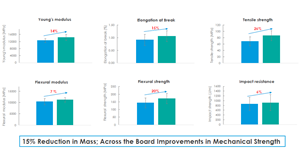Digital chemistry platform leverages physics-based modeling for enhanced workflow
CAMX 2024: Schrödinger introduces a digital chemistry software platform, designed to enable researchers to tackle materials challenges across diverse polymer resin and carbon fiber applications.
Share
Schrödinger (New York, N.Y., U.S.) introduces a digital chemistry software platform enabling the quick and cost-effective discovery of high-quality, novel molecules for materials applications. With Schrödinger’s digital chemistry platform, users can access advanced computational solutions leveraging physics-based modeling, machine learning and enterprise informatics to understand and predict product performance of polymers and composites at molecular and atomic scales. These solutions can enable researchers to tackle materials challenges across diverse polymer resin and carbon fiber applications.
Composite industry tailored workflows, tutorials and online courses are designed to enable companies to integrate digital chemistry into their existing workforce with minimal time and effort. Customized support is provided by Schrödinger’s polymer, composite and surface chemistry scientists.
Schrödinger’s software helps identify high-performance composites by:
- Modeling moisture aging and morphological stability in polymer composites
- Predicting glass transition, thermal stability and thermal expansion with custom resin formulations
- Predicting resin sizing compatibility for natural fibers
- Aiding in root cause analysis of materials-related issues.
At its booth, Schrödinger is providing a live demo on composite modeling. In addition, a presentation, “A multi-scale framework to determine effects of environmental conditions on composite parts using molecular dynamics and finite-element methods” by David Nicholson, principal scientist at Schrödinger, is available to visitors. It takes place on Tuesday, Sept. 10 from 2:30 – 2:55 p.m.
Related Content
-
CAMX 2023 abstract, award nomination applications are open
To participate in this year’s composites and advanced materials event in Atlanta, Georgia, consider submitting a technical paper/education session abstract by March 8th, or applying for the CAMX/ACE Awards by July 13th.
-
High-strength, nondestructive adhesive-bonded fasteners
CAMX 2023: Rotaloc bonding fasteners come in a variety of baseplate styles, threads, sizes and materials for high-strength, nondestructive bonding with fiber-reinforced composites and thermoset/thermoformed plastics.
-
Winding software developed for filament winding machines
CAMX 2023: Roth Composite Machinery focuses on automation, safety and time savings.
Related Content
CAMX 2023 abstract, award nomination applications are open
To participate in this year’s composites and advanced materials event in Atlanta, Georgia, consider submitting a technical paper/education session abstract by March 8th, or applying for the CAMX/ACE Awards by July 13th.
Read MoreHigh-strength, nondestructive adhesive-bonded fasteners
CAMX 2023: Rotaloc bonding fasteners come in a variety of baseplate styles, threads, sizes and materials for high-strength, nondestructive bonding with fiber-reinforced composites and thermoset/thermoformed plastics.
Read MoreWinding software developed for filament winding machines
CAMX 2023: Roth Composite Machinery focuses on automation, safety and time savings.
Read MoreGraphene-enhanced SMC boosts molded component properties
CAMX 2023: Commercially sold GrapheneBlack SMC from NanoXplore increases part strength, stiffness and provides other benefits for transportation, renewable energy, energy storage and industrial markets.
Read MoreRead Next
CoreTech, Xnovo bring 3D imaging to Moldex3D molding software
Moldex3D users will now be able to conduct accurate 3D fiber orientation simulations using calibrated fiber parameters.
Read MoreCOMSOL releases version 6.0 for multiphysics simulation software
COMSOL Multiphysics introduces platform feature for model management, adds module for uncertainty quantification analysis and includes important updates and performance enhancements, all with boosted productivity in mind.
Read MoreDeveloping bonded composite repair for ships, offshore units
Bureau Veritas and industry partners issue guidelines and pave the way for certification via StrengthBond Offshore project.
Read More









